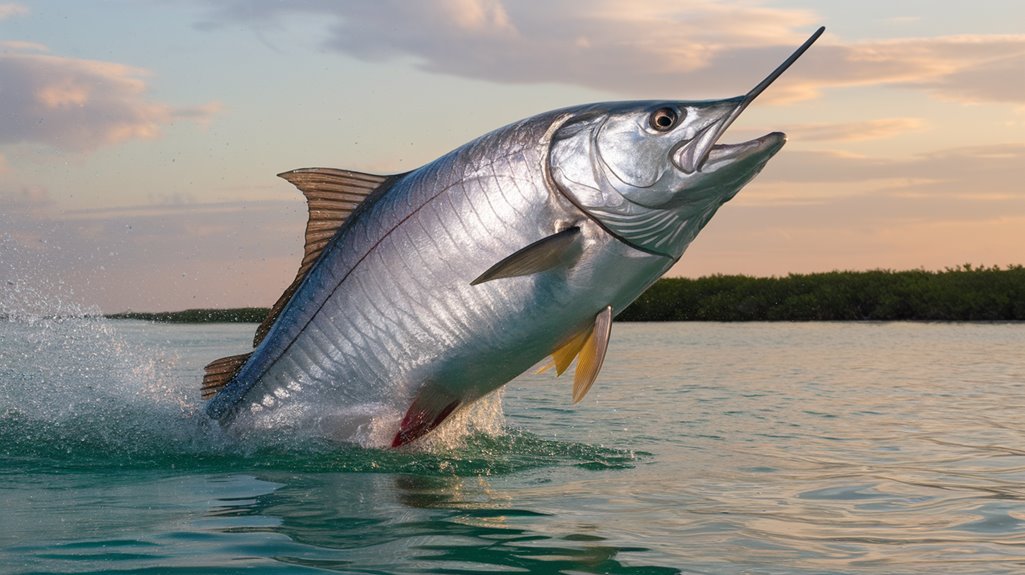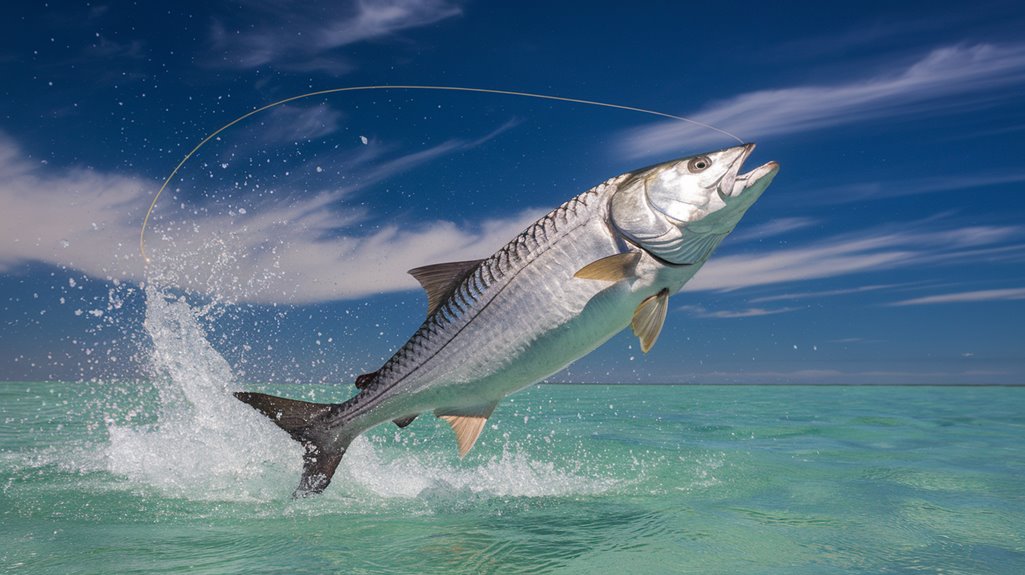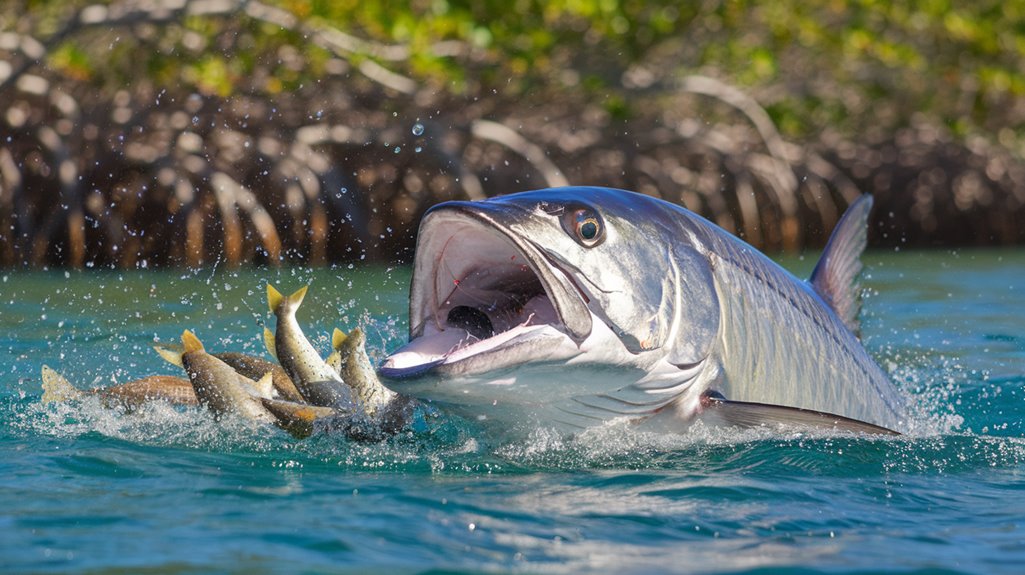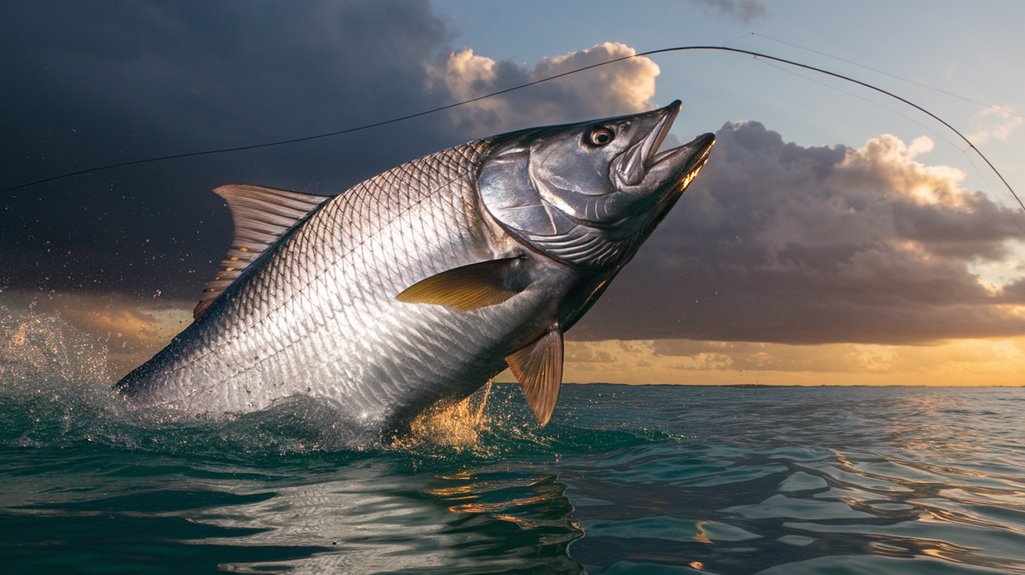You’ll discover that tarpon fishing isn’t just about landing the “silver king” – it’s a precise dance of technique, timing, and understanding. As these prehistoric giants patrol the flats and channels, you’ll need to master everything from their migration patterns to their feeding behaviors. Whether you’re planning to chase them in the backwaters of Florida or along Caribbean shores, your success depends on a deep understanding of their biology and the skills to present your offerings effectively.
- Key Takeaways
- Essential Tarpon Biology and Migration Patterns
- Reading Water and Weather Conditions
- Mastering the Art of Sight Fishing
- Advanced Casting Techniques and Presentations
- Tackle Selection and Equipment Setup
- Strategic Approaches to Different Habitats
- Understanding Feeding Behaviors and Patterns
- Seasonal Strategies for Peak Success
- Frequently Asked Questions
- Conclusion
Key Takeaways
- Successful tarpon fishing requires understanding migration patterns, with peak seasons occurring during August and September along the Texas coast.
- Master sight fishing techniques by scanning for rolling fish, V-shaped wakes, and bubbles while maintaining proper casting distance of 60-80 feet.
- Use 10-12 weight fly rods with high-capacity reels and 30-50 pound test fluorocarbon leaders for optimal equipment setup.
- Target areas during dawn and dusk, focusing on clean water conditions and water temperatures between 75°F and 85°F.
- Plan fishing trips around full and new moon phases during spawning season, considering both tidal movements and weather conditions.
Essential Tarpon Biology and Migration Patterns

While anglers keenly await tarpon’s arrival along the Texas coast each summer, these majestic gamefish follow a predictable migration pattern from the Yucatán Peninsula, reaching peak abundance during August and September. You’ll notice these fish heading offshore during full and new moons for spawning activities throughout late spring and summer months.
Understanding tarpon biology is vital for the sustainability of the tarpon fishery. These remarkable creatures can live beyond 80 years, with females taking about 10 years to reach sexual maturity. During their juvenile stage, you’ll find them adapting to low-oxygen environments in backbay creeks and estuaries, where they’ve developed the unique ability to gulp air using their specialized swim bladders. With specimens reaching up to 229 pounds in Texas waters, proper conservation practices like catch-and-release are essential.
Reading Water and Weather Conditions
When you’re searching for tarpon, success hinges on your ability to read both water and weather conditions effectively. Start by evaluating water clarity, as these predators prefer clean water for ideal feeding, particularly during early morning hours. You’ll need to factor in wind patterns, as light breezes create favorable surface conditions while reducing glare.
Understanding tidal movements is essential – incoming tides bring tarpon closer to shore following prey, while outgoing tides push them toward deeper waters. Monitor approaching weather fronts and barometric pressure drops, which often trigger increased feeding activity. Temperature variations greatly influence tarpon behavior, so target waters between 75°F and 85°F for best results. By combining these environmental indicators, you’ll maximize your chances of finding active fish during prime feeding periods.
Mastering the Art of Sight Fishing

The art of sight fishing for tarpon builds directly upon your ability to read water conditions. You’ll need to master the technique of scanning side-to-side from the bow, avoiding the common trap of tunnel vision that can cause you to miss vital opportunities.
Keep watch for telltale signs of tarpon activity, particularly during the early morning hours when calm waters provide ideal visibility. Look for rolling fish, V-shaped wakes, and bubbles that indicate active feeding behavior. You’ll find that tarpon at different depths present varying levels of visibility – higher fish appear clearer while deeper ones may seem more ghostlike. By sharpening your observation skills and learning to assess both the fish’s depth and speed accurately, you’ll greatly increase your chances of a successful presentation and catch.
Advanced Casting Techniques and Presentations
You’ll need to master the double-haul technique to achieve the distance and accuracy required for successful tarpon fishing, especially when casting into challenging wind conditions. When targeting schools of tarpon, your cast must place the fly precisely where it needs to be—directly in front of the lead fish—while maintaining enough line speed to cut through coastal breezes. Your presentation skills must combine subtle stripping patterns with perfect timing, ensuring your fly lands softly yet remains visible in the tarpon’s strike zone.
Distance and Accuracy Mastery
Successful tarpon fishing hinges on mastering advanced casting techniques that combine both distance and accuracy. You’ll need to perfect your double-haul casting to achieve the ideal 60-80 foot range where most productive presentations occur. This technique maximizes your line speed and guarantees precise delivery to feeding tarpon.
To enhance your accuracy, use a weight-forward floating line, which helps load your rod more effectively, especially in windy conditions. You’ll want to maintain a consistent rod tip height throughout your cast to prevent unwanted splash that could spook nearby fish. Once you’ve mastered the technical aspects of your cast, focus on your retrieve. Whether you’re using a slow strip or quick mend, your presentation should mimic natural prey movement to trigger strikes from actively feeding tarpon.
Wind-Resistant Cast Mechanics
While casting fundamentals remain constant, mastering wind-resistant techniques becomes paramount when targeting tarpon in challenging conditions. You’ll need to adapt your wind-resistant cast mechanics by employing a lower, more compact stroke and positioning your body at an angle to the wind. The double-haul technique provides essential line speed, helping you penetrate through turbulent air with greater efficiency.
- Minimize your back cast exposure while focusing on a quick, powerful forward stroke to maintain control
- Select heavier flies and increase your line weight to overcome strong wind resistance
- Keep your casting arc tight and controlled, reducing the line’s surface area against the wind
These adjustments to your casting mechanics will greatly improve your presentation success rate in windy conditions, making the difference between a solid hookup and a missed opportunity.
Presentation Under Pressure
Under intense pressure situations, presenting flies to rolling tarpon demands a perfect blend of advanced casting techniques and strategic presentation skills. You’ll need to master the double haul to generate the line speed necessary for reaching fish in challenging wind conditions.
When you spot those distinctive tarpon rolls, you’ll want to place your fly within striking distance, ideally within a few feet of the fish. Execute a well-timed mend to achieve a natural drift that mimics injured baitfish behavior. As you watch for tarpon looks, vary your retrieve pattern between slow strips and strategic pauses. This rhythmic presentation often triggers strikes from selective fish. By combining precise placement with deliberate line manipulation, you’ll maximize your chances of enticing these magnificent gamefish to take your fly.
Tackle Selection and Equipment Setup
You’ll need a 10-12 weight fly rod to handle the power and size of tarpon, paired with a high-capacity reel featuring a robust drag system that can manage long, fast runs. Your terminal tackle should include a 7-9 foot fluorocarbon leader in the 30-50 pound test range, providing the perfect balance of strength and stealth when presenting flies. For ideal results, stock your fly box with baitfish patterns like Clouser minnows and tarpon toads in proven colors such as white, chartreuse, and black.
Essential Rod Components
Selecting the right rod components for tarpon fishing can make the difference between landing a trophy fish and losing the battle. When choosing your essential rod components, you’ll need to focus on durability and performance. Tarpon tend to be aggressive fighters, so your setup must withstand intense pressure and sudden runs.
- Use a fast-action rod between 10-12 feet with a 10-12 weight rating for peak control and leverage during the fight
- Install a high-capacity reel that holds at least 300 yards of backing line and features a robust drag system
- Pair your setup with floating or intermediate line and an 80-pound test leader for maximum versatility
These specifications guarantee you’re equipped to handle the powerful runs, acrobatic jumps, and extended battles that make tarpon fishing such an exhilarating experience. Your rod’s components must work together seamlessly to give you the best chance of success.
Reel Selection Guidelines
Building upon your rod setup, the right reel becomes your next key consideration for tarpon fishing success. When following reel selection guidelines, you’ll need to focus on durability and performance in saltwater conditions. Choose a reel constructed from anodized aluminum that’s rated for 12 to 14-weight lines to handle tarpon’s explosive power.
You’ll want a large arbor design for quick line retrieval, which proves essential during those intense fights that can last up to 30 minutes. Your reel’s drag system must be smooth and fully adjustable to maintain consistent pressure throughout the battle. Remember to match your reel size to your rod weight, typically ranging from 10 to 14-weight. This guarantees proper balance and ideal performance when targeting these powerful gamefish.
Terminal Tackle Specifics
Proper terminal tackle selection forms the backbone of any successful tarpon fishing setup. You’ll need to equip your rig with a heavy-duty leader material, either fluorocarbon or monofilament, ranging from 80 to 130-pound test to handle the intense fights these giants deliver. Connect your terminal tackle using a loop knot for ideal bait presentation, and don’t forget to incorporate a robust ball bearing swivel rated at 200 pounds minimum.
- Select hooks between 7/0 to 10/0 size to guarantee solid hook-sets in a tarpon’s wide mouth
- Use premium fluorocarbon or monofilament leader material that’s both strong and corrosion-resistant
- Install a high-quality ball bearing swivel to prevent line twist, especially essential when working live bait
Your terminal tackle specifics must align with your rod and reel combo, supporting the substantial demands of landing these powerful gamefish.
Strategic Approaches to Different Habitats
When pursuing tarpon across diverse habitats, you’ll need to adapt your approach based on specific environmental conditions and seasonal patterns. For juvenile tarpon, focus your strategic approaches on backbay creeks within the Lower Laguna Madre, especially during summer months when they’re most active in these hypersaline waters.
You’ll find adult tarpon migrating in chains near Port Mansfield and South Padre Island jetties during August and September. Watch for their characteristic rolling and bubbles, which signal their presence. Adjust your presentations accordingly – use silver mullet, menhaden, or pinfish under corks in shallower waters, but switch to deeper presentations when targeting offshore areas. Success depends on matching your tactics to the specific environment, whether you’re fishing the hypersaline backwaters or deeper coastal zones.
Understanding Feeding Behaviors and Patterns

Successful tarpon fishing hinges on recognizing their distinctive feeding patterns and behaviors. You’ll find these magnificent fish most active during dawn and dusk, when they’re actively hunting prey. Understanding their surface-rolling behavior, which indicates both their location and feeding activity, is essential for timing your casts.
- Pay attention to lunar cycles during spawning season (late spring to summer), as feeding behaviors intensify around full and new moons
- Watch for schools and identify the lead fish, as this can reveal group feeding patterns
- Focus on areas where their preferred prey – mullet, menhaden, and pinfish – are abundant
Take advantage of tarpon’s air-gulping behavior by positioning yourself where you can spot their characteristic rolling motion. This natural behavior not only helps you locate them but also signals prime feeding opportunities.
Seasonal Strategies for Peak Success
To maximize your tarpon fishing success throughout the year, understanding Texas’s seasonal patterns becomes essential. You’ll find peak opportunities during August and September, when seasonal variations in water temperature and tides create ideal conditions. Begin your pursuit at South Padre Island, where migrating schools first appear along the coast.
Plan your trips around the full and new moons during late spring through summer, when spawning tarpon move offshore. You’ll achieve the best results by launching early, before sunrise, as these magnificent fish actively roll and feed in the calm morning waters. By monitoring water temperatures and adapting your techniques to tidal movements, you can effectively target tarpon throughout their seasonal journey, even as conditions change from spring through fall.
Frequently Asked Questions
Why Is It Illegal to Catch Tarpon in Florida?
You can’t harvest tarpon in Florida because they’re classified as a game fish requiring strict catch-and-release practices. This protects their slow-growing population and preserves their essential role in marine ecosystems.
Where Is the Best Tarpon Fishing in the World?
You’ll find the world’s best tarpon fishing in the Florida Keys, particularly around Boca Grande and Islamorada, during peak season from April to June, with Belize and Cuba offering exceptional alternatives.
What Month Is Best for Tarpon Fishing?
You’ll find the best tarpon fishing during peak summer months, especially August and September. The warm waters trigger migrations, and you’ll maximize your chances during full or new moons in these periods.
What Is the Lifespan of a Tarpon?
You’ll find that tarpon can live for over 80 years in the wild, with females typically reaching maturity around age 10-12 and males slightly earlier, making them remarkably long-lived fish.
Conclusion
You’ve now mastered the key elements of successful tarpon fishing. By understanding their biology, migration patterns, and feeding behaviors, you’re equipped to make informed decisions on the water. Whether you’re sight fishing in clear flats or working deeper channels, your enhanced casting skills and properly selected tackle will maximize your success. Remember to adjust your strategies based on seasonal patterns, particularly during the peak months of August and September.

